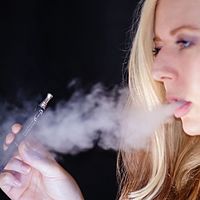
Photo from wikipedia
A novel gas chromatography (GC) method for quantitation of volatile organic compounds (VOCs) in 18F- and 11C-radiopharmaceuticals listed in the European Pharmacopoeia (Ph. Eur.) was proposed. Optimized chromatographic parameters were… Click to show full abstract
A novel gas chromatography (GC) method for quantitation of volatile organic compounds (VOCs) in 18F- and 11C-radiopharmaceuticals listed in the European Pharmacopoeia (Ph. Eur.) was proposed. Optimized chromatographic parameters were used for separation of ethanol, acetone, acetonitrile, tetrahydrofuran (THF), dibromomethane (DBM), 2-dimethylaminoethanol (deanol), N,N-dimethylformamide (DMF) and dimethyl sulfoxide (DMSO) which could be detected in radioactive drug samples. The calculated peak resolutions (RS) were higher than 2.0 at ethanol concentration of up to 11 m/m%. Reproducible results could be obtained using base deactivated fused silica wool as packing material of inlet liner. Validation parameters showed excellent linearity (r2 ≥0.9998) in the range from 10 to at least 120% of concentration limit of solvents. The accuracy was determined as recovery of concentrations which ranged from 99.3% to 103.8%. Additionally, the relative standard deviation (RSD) of each solvent for inter-day and intra-day precision were in the range of 0.5-4.2% and 0.4-4.4%, respectively. The limit of quantitation (LOQ) for ethanol, acetone, acetonitrile, THF, DBM, deanol, DMF and DMSO was 0.48, 0.42, 0.43, 0.46, 4.35, 0.73, 0.68 and 0.50 mg/L, respectively. The developed procedure was successively applied for quantitation of ethanol, acetone, acetonitrile and deanol in radioactive drug samples of [11C]methionine, [11C]choline, 2-deoxy-2-[18F]fluoro-D-glucose ([18F]FDG) and O-(2-[18F]fluoroethyl)-L-tyrosine ([18F]FET). The proposed GC method applying flame ionization detection (FID) could be adapted in routine quality control of most frequently used positron emission tomography (PET) radiopharmaceuticals to perform the determination of residual solvents with analysis time of 12 min.
Journal Title: Journal of pharmaceutical and biomedical analysis
Year Published: 2021
Link to full text (if available)
Share on Social Media: Sign Up to like & get
recommendations!